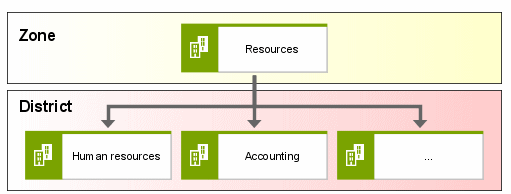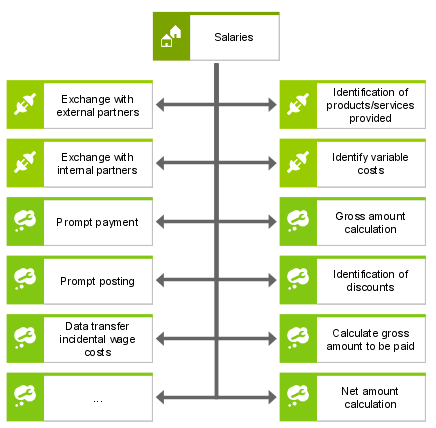Service view
ARIS provides the following model types for describing the Service view:

Service architecture diagram

Service architecture diagram (column display)

Service allocation diagram

Service collaboration diagram
The two service architecture models arrange the structural elements of the information system in a hierarchy.
An IS hierarchy can include the following levels:

Zone

District

Building cluster

Functional block

Capability

IS service

Business service
Zone, District, Building cluster, Functional block, and Business service are Service type object types. Service types are used to organize an information system in independent units/blocks by function.
Each service type is characterized in that it is the 'owner' of the data it uses and of the associated processing methods. Other service types can access these data and processing methods only if they call a service of the 'owner service type'.
Within a service type, similar data is used and identical activities and business functions are carried out.
At the top level, the information system is divided into zones. A zone can correspond to an operational and development area, for example.
The following figure shows the zones into which a company's information system can be typically broken down.
Each zone, in turn, can contain one or more districts.
Districts of a zone are characterized by a high degree of similarity in terms of processes and temporal features (e.g., similar lifecycles and information processing cycles). Districts can be terms of payment or of price, human resources administration, travel guidelines etc.
The Resources zone may include the Human resources and Accounting districts:
A district may contain one or more building clusters that serve a functional purpose, e.g., salary payments, invoicing, etc.
The Human resources district includes the Business unit administration, Recruiting, Human resources development, and Human resources support building clusters.
Each building cluster can encompass one or more functional blocks. Functional blocks are characterized by substantial similarity regarding the business objects and events they manage.
A functional block is an independent, reusable functional component. Capabilities and IS services are combined to form a functional block according to the following rules:

There is a close interrelationship between the objects they manage and the functions they support.

There is only minimal exchange with other functional blocks.
The building cluster Human resources support of the given example includes the Master data maintenance, References, Controlling, and Salaries functional blocks.
A capability is an elementary functionality within a system. It supports the realization of an activity within a process.
An IS service is an interface of a service type or a capability. IS services allow other IS elements controlled access to data and processing methods of the IS element that provides a service.
These interfaces can be used to exchange messages with other elements of the IS view.
The following figure shows the capabilities and IS services of the Salaries functional block.
For describing the IS hierarchy it is not necessary to entirely model all levels described here. The Capability and IS service IS elements are not regarded as elements of the city plan in IT City Planning. The city planner's tasks end at the building block level. Capabilities and IS services are the responsibility of the architect (see Longépé, Christoph: Le projet d'urbanisation du système d'information, p. 18).




